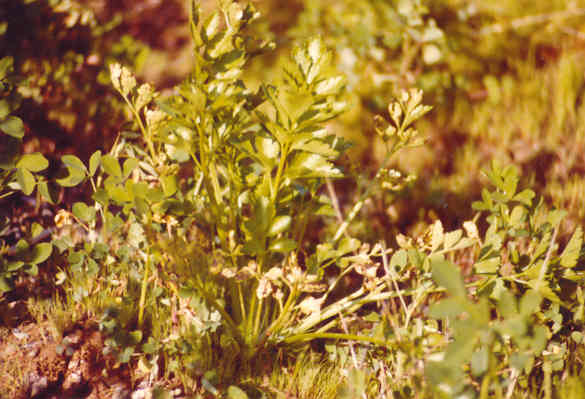
Apium graveolens L.
Apiaceae (Carrot Family)
Europe
 |
Apium graveolens L.Apiaceae (Carrot Family)Europe
Celery |
May Photo
Plant Characteristics:
Perennial caulescent herb, erect to ascending, 5-12 dm. tall, stems not
rooting at nodes; basal lvs. pinnate, 1-6 dm. long, petioled, the upper much
reduced; lfts. 5-9, 2.5-7 cm. long, the divisions ovate to suborbicular or
cuneate; petioles 3-25 cm. long; fls. white in compound umbels which are sessile
or short-peduncled; invol. and involucels none; rays 7-16; pedicels 1-6 mm.
long; fr. subglobose to ellipsoid, notched at tip, ca. 1.5 mm. long.
Habitat:
Common in wet places at low elevs.; San Nicolas Id.
May-July.
Name:
Latin, apium, parsley.
(Jaeger 22). Graveolens
means strong smelling. (Dale 46).
General:
Very common in the study area. The
photographed specimens were from the Delhi Ditch and along the road from the
Newporter Inn to San Joaquin Hills Dr. (my comments). Indians
used this plant as a potherb. The
Cahuillas, Indians of the Colorado Desert, the San Bernardino and San Jacinto
Mountains, made a tea for kidney complaints.
The tops should not be eaten due to the level of nitrates and should be
discarded. The wild plant, though
easily recognized by its smell, has a much stronger aftertaste than the
cultivated plant. For this reason
it is best mixed with other strong flavors or cooked rather than eaten raw. Ancient Greeks used Celery as an award at sports events.
Abyssinians stuffed pillows with Celery leaves as a cure for headache.
(Clarke 148). Greeks made a wine called selinites from wild celery
that grew around the Mediterranean Sea. (ref.
not recorded). The Indians dried the blossoms and used them as perfume.
(Murphy 57). Some people are allergic to celery,
and for them the real harm comes from poison, which is given off by the leaves
under conditions of considerable moisture.
This poison may produce a rash not unlike poison ivy.
This fact has not prevented celery from being a choice salad plant from
earliest times. It is said the
Romans enjoyed it and wore crowns of the leaves for dinner guests. Herbalists rate celery as having a calming quality to
the nerves and as a diuretic. (Coon
78). A tonic made
from celery is known to stimulate the sexual appetite, as an aphrodisiac. Celery is popular as a flavoring. There are several ways of absorbing the beneficial
ingredients. The oil in the
seeds may be extracted by compression or the seeds may be placed in a cup and
hot water poured on them or on the dried ripe fruit and allowed to steep for
one-half hour. The liquid is then
strained out and dosages of one or two tablespoonfuls at a time will be
sufficient for good results. (Kadans 89,90).
Celery root is a flavorsome and
tender starchy vegetable. (John
Johnson). A.
graveolens is known to accumulate free nitrates in quantities capable of
causing death or distress in cattle. (Fuller
384). Celery
seeds are used to flavor mayonnaise, French dressing, catsup, cream cheese,
salads, cabbage and beet dishes, potato and tomato dishes, soups, pickles, meat
loaf, hamburgers, sauces and gravies. (Meyer
180). Excellent
for use in incontinence of urine, dropsical
and liver troubles. Produces
perspiration, is a splendid tonic. Good
in rheumatism and neuralgia, also nervousness. (Kloss 231).
About 3 species of Eurasia and Southern
Hemisphere. (Munz, Flora So. Calif. 71).
Text Ref:
Munz, Calif. Flora 1010;
Hickman, Ed. 141; Munz, Flora So. Calif.
71.
Photo Ref:
Feb-Mar 83 # 14,15; May 4 83 # 7.
Identity: by R. De Ruff,
confirmed by G. Marsh.
Computer Ref: Plant Data 136.
No plant specimen.
Last edit 10/22/02.
 |
March Photo